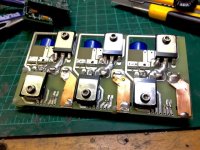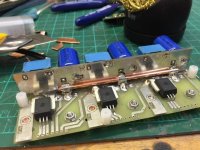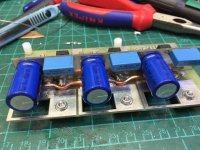the whole issue is my head all the time, so i tried to reconstruct what happened. i sent HUNDREDS of mails to lebowski (thanks for your support!!!) and can't remember what led to what, and what settings/tests work and which not. i wish i was a more methodical guy. i totally am NOT.

so not writing down my findings to be able to follow my doings. well, probably this is why i spam these threads and write mails to keep track of my thoughts.
so it suddenly flashed in my head, and i went through my mails: the situation the FET exploded was one of those "not correctly configured" controller situations. i flashed a 0xFFFF file to reset all to default, went through all testing, and when you do that, the "FOC measurement" settings for current are EXTREME. like a few THOUSAND amps, where it should be 20-40A (in my case). i forgot to set this to reasonable values. so this made the FET explode. could be that this also made the wires to the caps melt because of the EXTREME current flowing for a few ms.
i guess this is a reasonable explanation. what do you think?
why the LTC3638 just gave up? i don't know. this happened during testing, BEFORE the FET problem. but it first showed up after testing lebowski's "extreme" .hex files with some error current checking disabled, which is asked him for. i guess this is a valueable information now. i would vote AGAINST those settings. and it makes sense to me now. somehow the dc/dc converter was destroyed during that. and this also was the reason why FOC measurement etc didn't work correctly afterwards. if the chip's supply voltage drops below a certain treshold even for milliseconds it resets. you won't notice that with a DMM.
any comment really welcome. i'm confident now, that with new parts, and going through regular setup, everything is safe to use. can't wait to try andy's new design






